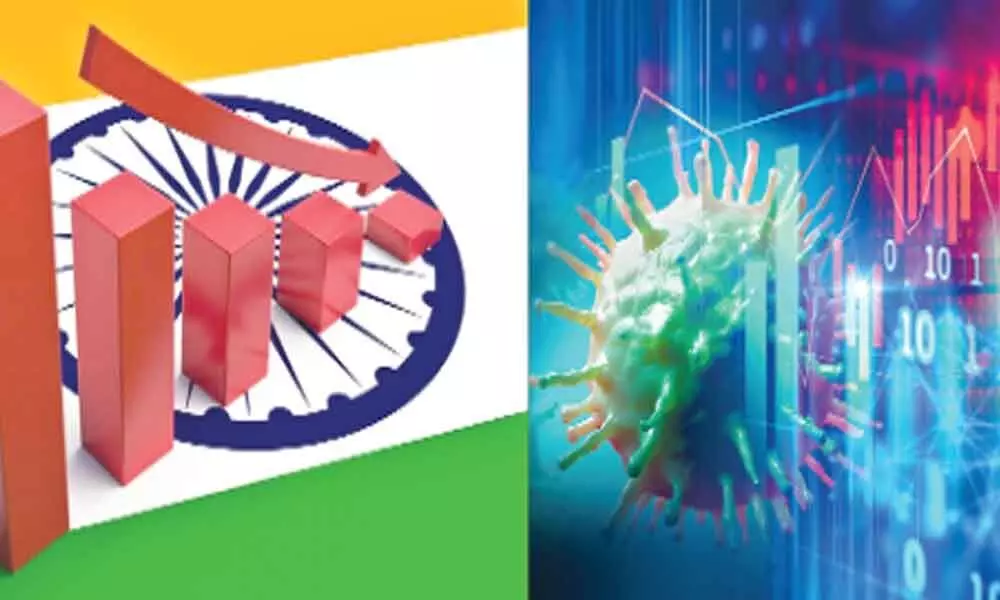Live
- HMPV Outbreaks Spark Global Health Concerns: What You Need to Know
- Gautam Gambhir Faces Criticism Over Tactical Errors in Australia Tour
- CM Revanth Reddy Announces Surprise District Tours Starting January 26
- Telangana's TOMCOM Invites Applications for Driver Jobs in Germany
- Calcutta HC rejects plea by rights body for stall allotment at Kolkata Book Fair
- Bengaluru Beer Prices to Rise by Up to 20% Starting January 20
- My Fans Are Like Disciplined Soldiers: Nandamuri Balakrishna
- Adani Group raises Rs 4,850 crore after selling 13.5 pc stake in Adani Wilmar
- "Jogulamba Gadwal Health Officials Assure Public: No Panic Over HMPV Virus".
- "Charity and Annadanam Program Held on BOSS Hanumanthu Naidu’s Birthday".
Just In

Q1 GDP shrinks 23.9%
1st economic contraction in 4 decades; Agriculture saving grace during April-June
Q1 chaos
• Construction down by 50.3%
• Mfg sector sees 39% decline
• Mining sector output falls 23%
• Agriculture clocks 3.4% upswing June
New Delhi: India's economy suffered its worst slump on record in April-June, with the gross domestic product (GDP) contracting by 23.9 per cent as the coronavirus-related lockdowns weighed on the already-declining consumer demand and investment.
The GDP contraction in the world's fifth-largest economy compared with 3.1 per cent growth in the preceding January-March quarter and 5.2 per cent expansion in the same period a year back, according to official data released on Monday.
This is the sharpest contraction since quarterly figures started being published in 1996 and worse than what was expected by most analysts.
While the pandemic caused historic GDP contractions in economies around the world, the situation in India has been made worse by more than 78,000 new infections a day and total cases topping 35 lakh - behind only the US and Brazil.
The US economy shrank at a dizzying 32.9 per cent annual rate in the April-June quarter - by far the worst quarterly plunge ever - when the viral outbreak shut down businesses, throwing tens of millions out of work and sending unemployment surging to 14.7 per cent.Chief Economic Adviser K V Subramanian said that the first-quarter economic performance was "driven primarily due to an exogenous shock that has been felt globally."
During April-June, agriculture was the lone bright spot, growing by 3.4 per cent. Financial services - the biggest component of India''s dominant services sector - shrank 5.3 per cent, while trade, hotels, transport and communication declined 47 per cent.
Manufacturing shrank 39.3 per cent, construction contracted 50.3 per cent, mining output fell 23.3 per cent, and electricity and gas segment dropped 7 per cent. Subramanian said the economy is 'experiencing a V-shaped recovery' after the lockdown eased.
But the Reserve Bank of India (RBI) in its annual report last week said the economy is likely to contract even in the second quarter (July-September). Finance Minister Nirmala Sitharaman has already warned of a contraction for the full year because of the "act of God".
Economists expect growth to rebound only in the next year, mostly led by pent-up domestic demand and pick up in the manufacturing and services sectors after the easing of lockdown.
While the nationwide lockdown wiped away economic activity for almost half of the first quarter of 2020-21 fiscal, local lockdowns by several states thereafter and continuing restrictions on sectors such as hospitality, transport, and education have dented revival prospects. Analysts say millions of workers lost their jobs and businesses suffered due to the lockdown, but the government has refuted any large-scale unemployment.
Even before the pandemic struck, the Indian economy was in the midst of a slowdown as a crisis in the shadow bank sector hurt new loans and took a toll on consumption, which accounts for some 60 per cent of the country's GDP. According to the data released by the National Statistical Office (NSO), "GDP at Constant (2011-12) Prices in Q1 of 2020-21 is estimated at Rs 26.90 lakh crore, as against Rs 35.35 lakh crore in Q1 of 2019-20, showing a contraction of 23.9 percent as compared to 5.2 percent growth in Q1 2019-20."
"With a view to containing the spread of the Covid-19 pandemic, restrictions were imposed on the economic activities not deemed essential, as also on the movement of people from March 25, 2020. "Though the restrictions have been gradually lifted, there has been an impact on the economic activities as well as on the data collection mechanisms," it added.
It also said the timelines for filing statutory returns were extended by most regulatory bodies. "In these circumstances, the usual data sources were substituted by alternatives like GST, interactions with professional bodies, etc. and which were clearly limited," it said.

© 2025 Hyderabad Media House Limited/The Hans India. All rights reserved. Powered by hocalwire.com







